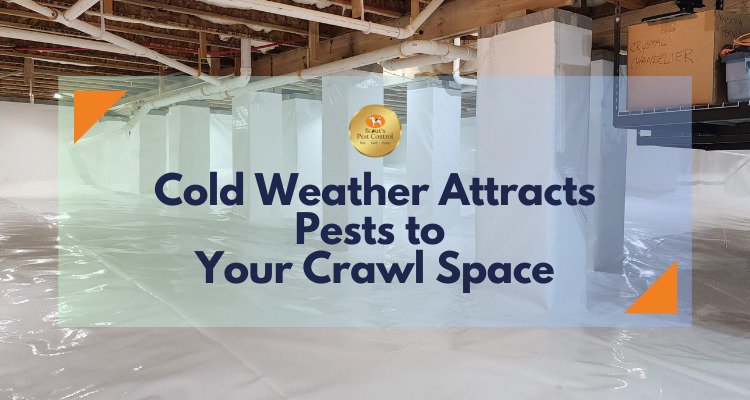Subterranean termites are a type of termite species that reside underground and are known for their destructive behavior. These termites cause billions of dollars in property damage every year and are a major pest problem for homeowners. You will often find these types of termites and their damage within your crawl space. These termites are highly prevalent in South Carolina. The environment within a crawl space is often the perfect conditions for termites to survive and thrive.

Subterranean termites live in large colonies and form complex social structures. There exists a clear division of labor between workers, soldiers, and reproductive individuals. They feed on wood, paper, and other cellulose-based materials, which makes them a threat to wooden structures such as homes and buildings. Moreover they are more prevalent in the crawl space where these conditions exist in abundance.
However, subterranean termites have really unique behaviors. Understanding these patterns can be advantageous intelligence in the fight to protect your home. Prevention is often better than the cure.
Key Behaviors of The Subterranean Termites
One of the key behaviors of subterranean termites is their ability to build elaborate tunnel systems. These tunnels, also known as mud tubes, serve as a protected pathway for the termites to travel from their underground nests to the above-ground food source. The tunnels are made of a mixture of soil, saliva, and feces and provide moisture and protection from predators. The first indication of the existence of mud tubes if they are not clearly visible is the fras they leave behind.

Understanding Termite Behavior:
It is important to understand termite behavior. In knowing how they behave in their colonies, a termite specialist is able to disrupt that pattern and bring swift remediation to the potential damage of invading termite colonies. The following is an understanding of their patterns.
Typical Patterns
Feeding: Subterranean termites feed on wood and other cellulose-based materials, such as paper, cardboard, and even some plastic products. They are attracted to moist or rotting wood, and they can enter a building through cracks in the foundation or through underground tunnels. If your crawl space, has a high moisture content, this is one of the main culprits of wood decay and rot.
Nesting: Subterranean termites build their nests underground, usually near a food source. They construct intricate tunnels and chambers to protect their eggs, nymphs, and workers. The queen termite is the largest and most important individual in the colony, and she is responsible for laying hundreds of eggs each day. They replicate fast and you often find several colonies in the same area.
Communication: Subterranean termites communicate with each other through pheromones, chemical signals that are used to coordinate their activities. For example, when a worker termite finds a food source, it releases a pheromone that attracts other workers to the area.

Swarm: Subterranean termites swarm when they are ready to mate and start a new colony. During a swarm, winged males and females fly out of their nest and mate in the air. After mating, the females land and shed their wings, and they then begin to lay eggs and establish a new colony.
Defense: Subterranean termites have a number of defense mechanisms to protect their colony from predators. For example, they secrete a sticky substance that clogs the mouthparts of ants and other predators, and they can also release a pheromone that attracts other termites to the area to help defend their colony.
Termite Behavior Feeding Frenzy 24/7
Another behavior that makes subterranean termites so damaging is their ability to work in large groups. These termites can eat through large sections of wood in a short period of time, making it difficult to stop their spread. In addition, they can also quickly adapt to new environments and change their behavior in response to obstacles.
Featured Termite Behavior You Should Be Aware Of
Subterranean termites are also known for their ability to reproduce rapidly, allowing their colonies to grow quickly and become established. The reproductive individuals of the colony can lay thousands of eggs in a single season, leading to the formation of new colonies in other parts of the structure. Your crawl space could become infested with several colonies in a very short space of time. The risk of incremental damage to the building structure is incredibly high.
Termite Prevention

Preventing subterranean termite infestations is an important step in protecting your property from damage. This can be achieved through proper moisture management, eliminating wood-to-soil contact, and using chemical treatments. In severe cases, fumigation may be necessary to completely eliminate the termites.
However, one of the most proactive approaches to protecting your home from damaging termite colonies is to encapsulate your crawl space. If you want to know about all the benefits of encapsulation and installing moisture remediation such as french drains and dehumidifiers, read our article here.
Protect Your Home
In conclusion, subterranean termites are a destructive species that pose a major threat to wooden structures. Their ability and patterns of behavior especially their adaptability to new environments make them difficult to control. However, with proper prevention measures in place, homeowners can protect their property from termite damage. Book your free crawl space inspection at scoutspestcontrol.com.





